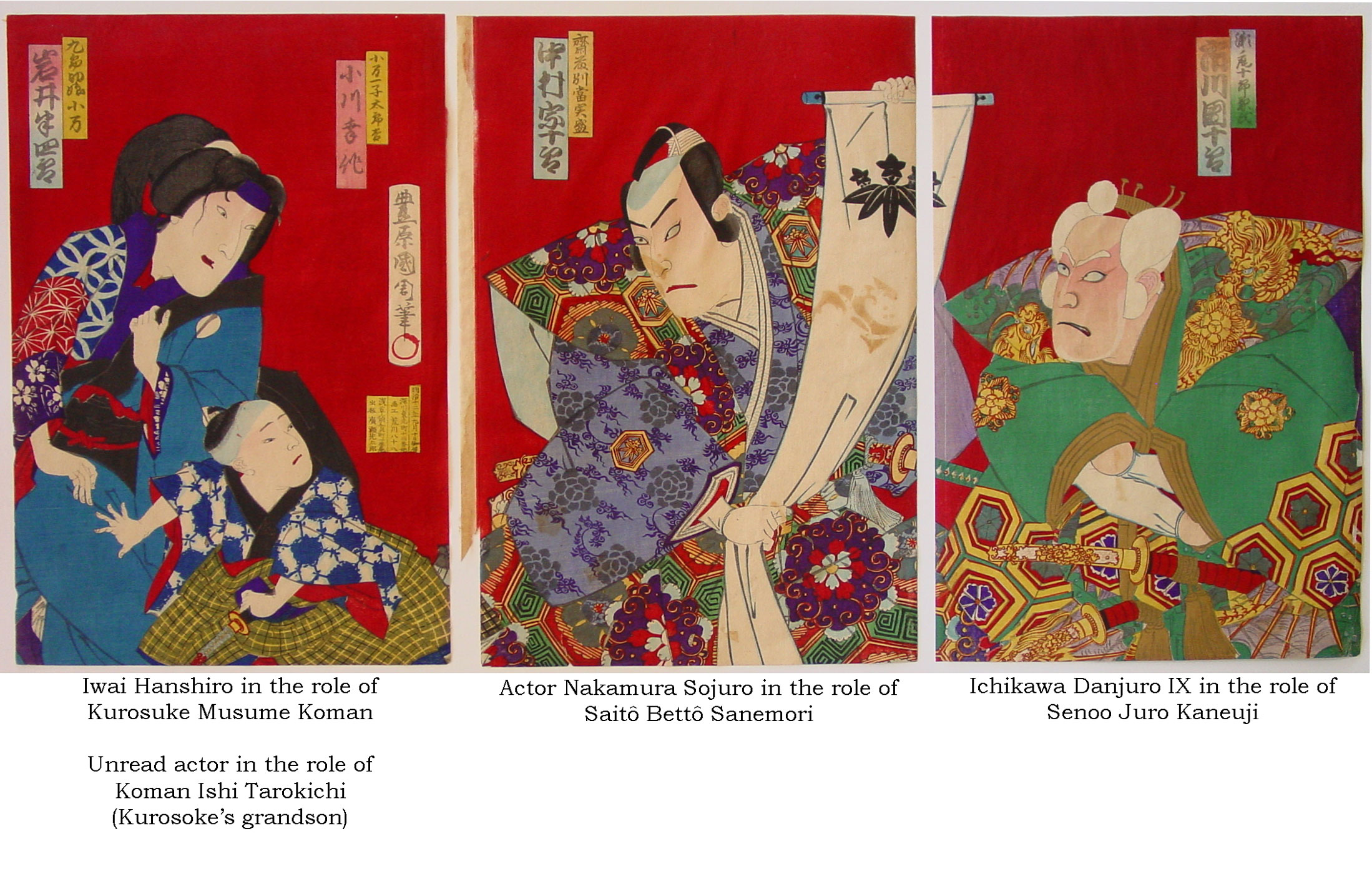About This Print
The Database Record of Kyoto University Art and Design's Yakusha-e Print Collection
Source: Database record from the Yakusha-e Prints from Kyoto University Art and Design http://kensaku.kyoto-art.ac.jp/ukiyoe/result_pict_e.php?no=1486Catalog # 726-3
| Artist : Kunichika Signature/seal : 「Toyohara Kunichika hitsu」(Toshidamain) Performance date : Theater : Name of play : Music : Batate : Shosadai : Details : Show name : Theater : Content details : General commentary : Individual commentary : |
| Left Sheet: Format : Oban nishikie sanmaitsuzuki Measurements : 366×250 Work Location : 3/3 Edition : Duplication : Subject : Series name : Cast : Koman Ishi Tarokichi Actor name : Cast : Kurosuke Musume Koman Actor name : Iwai Hanshiro Carver : ━ Seal change : Meiji yuninen kugatsutokaotodoke Seal : ━ Printer : Gako Arakawa Yasosohachi Shuppan Hirose Kotaro Print date : 1879 / 9 / 10 | Middle Sheet: Format : Oban nishikie sanmaitsuzuki Measurements : 368×244 Work Location : 2/3 Edition : Duplication : Subject : Series name : Cast : Saito Betto Sanemori Actor name : Nakamura Sojyuro | Right Sheet: Format : Oban nishikie sanmaitsuzuki Measurements : 368×248 Work Location : 1/3 Edition : Duplication : Subject : Series name : Cast : Senoo Jyuro Kaneuji Actor name : Ichikawa Danjyuro |
The Actors Pictured
Source: Kabuki 21 websitehttp://www.kabuki21.com/danjuro9.php
Ichikawa Danjūrō IX( 1838 ~ 13 September 1903) belonged to the triumvirate of stars who dominated the Kabuki world during the Meiji era. (The two others were Onoe Kikugorō V and Ichikawa Sadanji I.) He spent lots of time and energy pioneering a new genre called katsureki but the Tokyo audience was more receptive to his amazing performances in the great roles of Kabuki like Ôboshi Yuranosuke ("Kanadehon Chūshingura"), Kumagai Jirō Naozane ("Kumagai Jin'ya"), Sukeroku ("Sukeroku Yukari no Edo Zakura") or Benkei ("Kanjinchō").
"Ichikawa Danjūrō, the ninth, was the torch-bearer of Kabuki during the long reign of the Emperor Mutsuhito, known as the Meiji era, which endured for forty-five years ( 1868-1912). Danjūrō, the ninth, was the bridge that spanned the sudden gulf which yawned between the traditional past and the uncertain and changing modern world. He may be regarded as the saviour of Kabuki during a period when it might have suffered shipwreck, had there not been a man of genius at the helm to guide the craft through the troubled waters." (Zoë Kincaid in "Kabuki, the Popular Stage of Japan")
http://www.kabuki21.com/nsojuro2.php
Nakamura Sōjūrō (1835 ~ 8 October 1889) was an outstanding and very popular wagotoshi, competing with Jitsukawa Enjaku I for the title of best Kamigata tachiyaku. It is said that Nakamura Sōjūrō and Jitsukawa Enjaku I were the equivalent in Osaka of Ichikawa Danjūrō IX and Onoe Kikugorō V in Edo. Nakamura Sōjūrō also acted in a wider range of roles, from katakiyaku to onnagata (for example the difficult role of Sodehagi in "Ōshū Adachi-ga-Hara"). He was opposed to the Meiji theater reforms and temporarily left the stage to open a dry goods business. Fans' pressure was so strong that he quickly returned to the stage.
http://www.kabuki21.com/hanshiro4.php
Iwai Hanshirō VIII (2 October 1829 ~ 19 February 1882), who was both tall and good-looking, was an excellent onnagata, especially in the sewamono roles, and considered as the worthy heir of his grand-father Iwai Tojaku. He costarred with the best tachiyaku from the last years of the Edo period to the first years of Meiji such as Ichikawa Danjūrō VIII, Kataoka Nizaemon VIII, Bandō Hikosaburō V, Ichikawa Kodanji IV, Nakamura Shikan IV, Onoe Kikugorō V and Ichikawa Danjūrō IX. He was one of the last true Edo onnagata.
The Play Gempei Nunobiki no Taki
Source:Kabuki 21 website http://www.kabuki21.com/sanemori.php (Summary written by Watanabe Hisao and edited by Jeff Blair)The play in five acts Gempei Nunobiki no Taki (The Genji and Heike at Nunobiki Waterfall) was originally written for the puppet theater in 1749. It was adapted for Kabuki in September 1757, produced by the zamoto Anegawa Daikichi in Osaka at the Kado no Shibai. It was staged in Edo for the first time in January 1757 at the Moritaza.
Among classical Kabuki dramas there are some which border on fantasy and this is one of them. A woman, for example, is believed to have given birth to a full-grown human arm, rather than a baby. And later, when this same arm is rejoined to the woman's body from which it came, the dead woman comes back to life for a while.
Print Details
| IHL Catalog | #291 |
| Title (Description) | Ichikawa Danjūrō IX, Nakamura Sōjūrō and Iwai Hanshirō VIII in Gempei Nunobiki no Taki |
| Artist | Toyohara Kunichika (1835–1900) |
| Signature | Toyohara Kunichika hitsu |
| Seal | Toshidama |
| Publication Date | September 10, 1879 |
| Publisher |  Right column: 画工 gakō (artist) 荒川八十八 Arakawa Yasohachi (the artist's given name) followed by his address |
| Carver | not shown |
| Impression | excellent |
| Colors | excellent |
| Condition | good- minor wrinkling, several pin holes, right edge of lower right panelrepaired with Japanese paper tape, discoloration on center panel and a1” repaired tear on lower left edge of center panel |
| Genre | ukiyo-e; nigao-e; yakusha-e |
| Miscellaneous | |
| Format | vertical oban triptych |
| H x W Paper | 13 7/8 x 9 1/4 in. (35.2 x 23.5 cm) each sheet |
| Literature | |
| Collections This Print | Kyoto University of Art and Design 726-1, -2, -3 |


